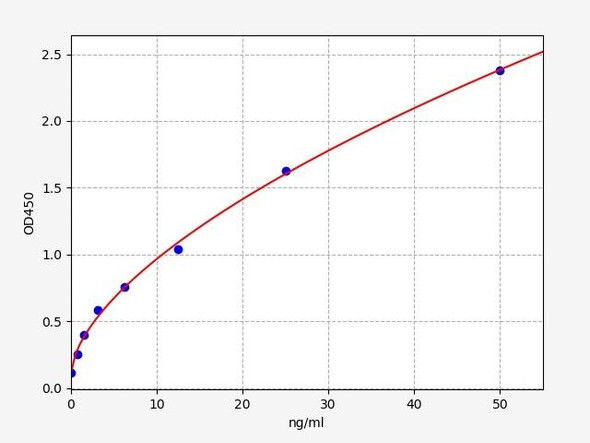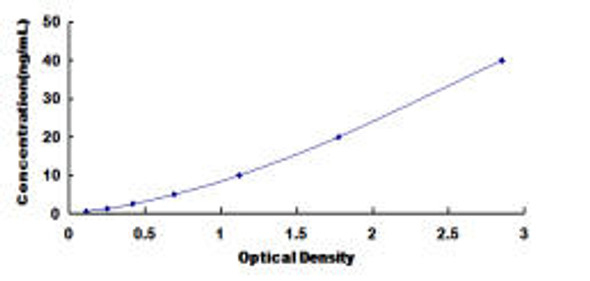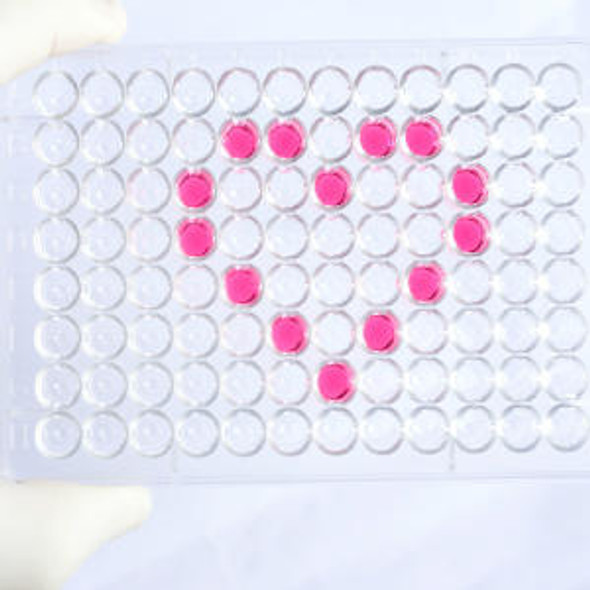Human BAK1 / BCL2-antagonist / killer 1 isoform 1 ELISA Kit
- SKU:
- HUFI02248
- Product Type:
- ELISA Kit
- Size:
- 96 Assays
- Uniprot:
- Q16611
- Sensitivity:
- 0.375ng/ml
- Range:
- 0.625-40ng/ml
- ELISA Type:
- Sandwich
- Synonyms:
- BAK1, BAK, BCL2L7, Apoptosis regulator BAK, BAK-LIKE, BAKMGC3887, BCL2-antagonist, killer 1, Bcl2-L-7, bcl2-L-7, BCL2L7bcl-2 homologous antagonist, killer, BCL2-like 7 protein, Bcl-2-like protein 7, CDN1, MGC117255, pro-apoptotic protein BAK
- Reactivity:
- Human
- Research Area:
- Cell Death
Description
Human BAK1 / BCL2-antagonist / killer 1 isoform 1 ELISA Kit
BAK1 / BCL2-antagonist / killer 1 isoform 1 belongs to the BCL2 protein family, and acts as an apoptotic regulator. BAK1 / BCL2-antagonist / killer 1 isoform 1 localizes to mitochondria, accelerates the opening of the mitochondrial voltage-dependent anion channel, which leads to a loss in membrane potential and the release of cytochrome c. BAK1 / BCL2-antagonist / killer 1 isoform 1 also induces apoptosis by interacting with the tumor suppressor P53 after exposure to cell stress. Diseases associated with BAK1 / BCL2-antagonist / killer 1 isoform 1 include Absolute Glaucoma and Keratoacanthoma.
| Product Name: | Human BAK1 / BCL2-antagonist / killer 1 isoform 1 ELISA Kit |
| Product Code: | HUFI02248 |
| Size: | 96 Assays |
| Alias: | BAK1, BAK, BCL2L7, Apoptosis regulator BAK, BAK-LIKE, BAKMGC3887, BCL2-antagonist, killer 1, Bcl2-L-7, bcl2-L-7, BCL2L7bcl-2 homologous antagonist, killer, BCL2-like 7 protein, Bcl-2-like protein 7, CDN1, MGC117255, pro-apoptotic protein BAK |
| Detection method: | Sandwich ELISA, Double Antibody |
| Application: | This immunoassay kit allows for the in vitro quantitative determination of Human BAK1 concentrations in serum plasma and other biological fluids. |
| Sensitivity: | 0.375ng/ml |
| Range: | 0.625-40ng/ml |
| Storage: | 4°C for 6 months |
| Note: | For Research Use Only |
| Recovery: | Matrices listed below were spiked with certain level of Human BAK1 and the recovery rates were calculated by comparing the measured value to the expected amount of Human BAK1 in samples. | ||||||||||||||||
| |||||||||||||||||
| Linearity: | The linearity of the kit was assayed by testing samples spiked with appropriate concentration of Human BAK1 and their serial dilutions. The results were demonstrated by the percentage of calculated concentration to the expected. | ||||||||||||||||
| |||||||||||||||||
| CV(%): | Intra-Assay: CV<8% Inter-Assay: CV<10% |
| Component | Quantity | Storage |
| ELISA Microplate (Dismountable) | 8×12 strips | 4°C for 6 months |
| Lyophilized Standard | 2 | 4°C/-20°C |
| Sample/Standard Dilution Buffer | 20ml | 4°C |
| Biotin-labeled Antibody(Concentrated) | 120ul | 4°C (Protect from light) |
| Antibody Dilution Buffer | 10ml | 4°C |
| HRP-Streptavidin Conjugate(SABC) | 120ul | 4°C (Protect from light) |
| SABC Dilution Buffer | 10ml | 4°C |
| TMB Substrate | 10ml | 4°C (Protect from light) |
| Stop Solution | 10ml | 4°C |
| Wash Buffer(25X) | 30ml | 4°C |
| Plate Sealer | 5 | - |
Other materials and equipment required:
- Microplate reader with 450 nm wavelength filter
- Multichannel Pipette, Pipette, microcentrifuge tubes and disposable pipette tips
- Incubator
- Deionized or distilled water
- Absorbent paper
- Buffer resevoir
| Uniprot | Q16611 |
| UniProt Protein Function: | BAK1: In the presence of an appropriate stimulus, accelerates programmed cell death by binding to, and antagonizing the anti- apoptotic action of BCL2 or its adenovirus homolog E1B 19k protein. Low micromolar levels of zinc ions inhibit the promotion of apoptosis. Interacts with BCL2A1. Homodimer. Formation of the homodimer is zinc-dependent. Forms heterodimers with BCL2, E1B 19k protein, and BCL2L1 isoform Bcl-X(L). Interacts with myxoma virus protein M11L. Expressed in a wide variety of tissues, with highest levels in the heart and skeletal muscle. Belongs to the Bcl-2 family. |
| UniProt Protein Details: | Protein type:Membrane protein, integral; Mitochondrial; Endoplasmic reticulum; Apoptosis Chromosomal Location of Human Ortholog: 6p21.3 Cellular Component: cytosol; endoplasmic reticulum; integral to mitochondrial outer membrane; mitochondrial outer membrane; mitochondrion; pore complex Molecular Function:BH domain binding; chaperone binding; heat shock protein binding; identical protein binding; metal ion binding; protein binding; protein heterodimerization activity; protein homodimerization activity Biological Process: aging; apoptosis; B cell apoptosis; B cell homeostasis; B cell negative selection; blood vessel remodeling; brain development; caspase activation via cytochrome c; cell proliferation; cytolysis; DNA damage response, signal transduction resulting in induction of apoptosis; endocrine pancreas development; endoplasmic reticulum calcium ion homeostasis; establishment and/or maintenance of transmembrane electrochemical gradient; limb morphogenesis; mitochondrial fusion; myeloid cell homeostasis; negative regulation of cell proliferation; negative regulation of peptidyl-serine phosphorylation; organ regeneration; positive regulation of apoptosis; positive regulation of proteolysis; post-embryonic camera-type eye morphogenesis; programmed cell death; reduction of endoplasmic reticulum calcium ion concentration; regulation of cell cycle; regulation of mitochondrial membrane permeability; regulation of mitochondrial membrane potential; regulation of protein heterodimerization activity; regulation of protein homodimerization activity; release of cytochrome c from mitochondria; response to drug; response to ethanol; response to fungus; response to gamma radiation; response to hydrogen peroxide; response to mycotoxin; response to organic cyclic substance; response to UV-C; unfolded protein response, activation of signaling protein activity; vagina development |
| NCBI Summary: | The protein encoded by this gene belongs to the BCL2 protein family. BCL2 family members form oligomers or heterodimers and act as anti- or pro-apoptotic regulators that are involved in a wide variety of cellular activities. This protein localizes to mitochondria, and functions to induce apoptosis. It interacts with and accelerates the opening of the mitochondrial voltage-dependent anion channel, which leads to a loss in membrane potential and the release of cytochrome c. This protein also interacts with the tumor suppressor P53 after exposure to cell stress. [provided by RefSeq, Jul 2008] |
| UniProt Code: | Q16611 |
| NCBI GenInfo Identifier: | 2493274 |
| NCBI Gene ID: | 578 |
| NCBI Accession: | Q16611.1 |
| UniProt Secondary Accession: | Q16611,Q6I9T6, Q92533, C0H5Y7, |
| UniProt Related Accession: | Q16611 |
| Molecular Weight: | 16,872 Da |
| NCBI Full Name: | Bcl-2 homologous antagonist/killer |
| NCBI Synonym Full Names: | BCL2 antagonist/killer 1 |
| NCBI Official Symbol: | BAK1 |
| NCBI Official Synonym Symbols: | BAK; CDN1; BCL2L7; BAK-LIKE |
| NCBI Protein Information: | bcl-2 homologous antagonist/killer |
| UniProt Protein Name: | Bcl-2 homologous antagonist/killer |
| UniProt Synonym Protein Names: | Apoptosis regulator BAK; Bcl-2-like protein 7; Bcl2-L-7 |
| UniProt Gene Name: | BAK1 |
| UniProt Entry Name: | BAK_HUMAN |
*Note: Protocols are specific to each batch/lot. For the correct instructions please follow the protocol included in your kit.
Before adding to wells, equilibrate the SABC working solution and TMB substrate for at least 30 min at 37°C. When diluting samples and reagents, they must be mixed completely and evenly. It is recommended to plot a standard curve for each test.
| Step | Protocol |
| 1. | Set standard, test sample and control (zero) wells on the pre-coated plate respectively, and then, record their positions. It is recommended to measure each standard and sample in duplicate. Wash plate 2 times before adding standard, sample and control (zero) wells! |
| 2. | Aliquot 0.1ml standard solutions into the standard wells. |
| 3. | Add 0.1 ml of Sample / Standard dilution buffer into the control (zero) well. |
| 4. | Add 0.1 ml of properly diluted sample ( Human serum, plasma, tissue homogenates and other biological fluids.) into test sample wells. |
| 5. | Seal the plate with a cover and incubate at 37 °C for 90 min. |
| 6. | Remove the cover and discard the plate content, clap the plate on the absorbent filter papers or other absorbent material. Do NOT let the wells completely dry at any time. Wash plate X2. |
| 7. | Add 0.1 ml of Biotin- detection antibody working solution into the above wells (standard, test sample & zero wells). Add the solution at the bottom of each well without touching the side wall. |
| 8. | Seal the plate with a cover and incubate at 37°C for 60 min. |
| 9. | Remove the cover, and wash plate 3 times with Wash buffer. Let wash buffer rest in wells for 1 min between each wash. |
| 10. | Add 0.1 ml of SABC working solution into each well, cover the plate and incubate at 37°C for 30 min. |
| 11. | Remove the cover and wash plate 5 times with Wash buffer, and each time let the wash buffer stay in the wells for 1-2 min. |
| 12. | Add 90 µl of TMB substrate into each well, cover the plate and incubate at 37°C in dark within 10-20 min. (Note: This incubation time is for reference use only, the optimal time should be determined by end user.) And the shades of blue can be seen in the first 3-4 wells (with most concentrated standard solutions), the other wells show no obvious color. |
| 13. | Add 50 µl of Stop solution into each well and mix thoroughly. The color changes into yellow immediately. |
| 14. | Read the O.D. absorbance at 450 nm in a microplate reader immediately after adding the stop solution. |
When carrying out an ELISA assay it is important to prepare your samples in order to achieve the best possible results. Below we have a list of procedures for the preparation of samples for different sample types.
| Sample Type | Protocol |
| Serum | If using serum separator tubes, allow samples to clot for 30 minutes at room temperature. Centrifuge for 10 minutes at 1,000x g. Collect the serum fraction and assay promptly or aliquot and store the samples at -80°C. Avoid multiple freeze-thaw cycles. If serum separator tubes are not being used, allow samples to clot overnight at 2-8°C. Centrifuge for 10 minutes at 1,000x g. Remove serum and assay promptly or aliquot and store the samples at -80°C. Avoid multiple freeze-thaw cycles. |
| Plasma | Collect plasma using EDTA or heparin as an anticoagulant. Centrifuge samples at 4°C for 15 mins at 1000 × g within 30 mins of collection. Collect the plasma fraction and assay promptly or aliquot and store the samples at -80°C. Avoid multiple freeze-thaw cycles. Note: Over haemolysed samples are not suitable for use with this kit. |
| Urine & Cerebrospinal Fluid | Collect the urine (mid-stream) in a sterile container, centrifuge for 20 mins at 2000-3000 rpm. Remove supernatant and assay immediately. If any precipitation is detected, repeat the centrifugation step. A similar protocol can be used for cerebrospinal fluid. |
| Cell culture supernatant | Collect the cell culture media by pipette, followed by centrifugation at 4°C for 20 mins at 1500 rpm. Collect the clear supernatant and assay immediately. |
| Cell lysates | Solubilize cells in lysis buffer and allow to sit on ice for 30 minutes. Centrifuge tubes at 14,000 x g for 5 minutes to remove insoluble material. Aliquot the supernatant into a new tube and discard the remaining whole cell extract. Quantify total protein concentration using a total protein assay. Assay immediately or aliquot and store at ≤ -20 °C. |
| Tissue homogenates | The preparation of tissue homogenates will vary depending upon tissue type. Rinse tissue with 1X PBS to remove excess blood & homogenize in 20ml of 1X PBS (including protease inhibitors) and store overnight at ≤ -20°C. Two freeze-thaw cycles are required to break the cell membranes. To further disrupt the cell membranes you can sonicate the samples. Centrifuge homogenates for 5 mins at 5000xg. Remove the supernatant and assay immediately or aliquot and store at -20°C or -80°C. |
| Tissue lysates | Rinse tissue with PBS, cut into 1-2 mm pieces, and homogenize with a tissue homogenizer in PBS. Add an equal volume of RIPA buffer containing protease inhibitors and lyse tissues at room temperature for 30 minutes with gentle agitation. Centrifuge to remove debris. Quantify total protein concentration using a total protein assay. Assay immediately or aliquot and store at ≤ -20 °C. |
| Breast Milk | Collect milk samples and centrifuge at 10,000 x g for 60 min at 4°C. Aliquot the supernatant and assay. For long term use, store samples at -80°C. Minimize freeze/thaw cycles. |
Fill out our quote form below and a dedicated member of staff will get back to you within one working day!






